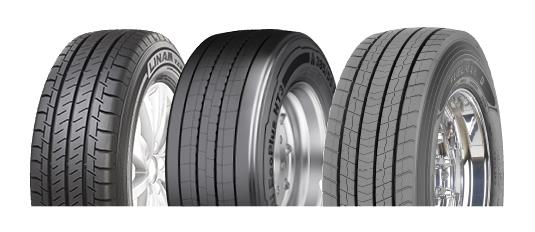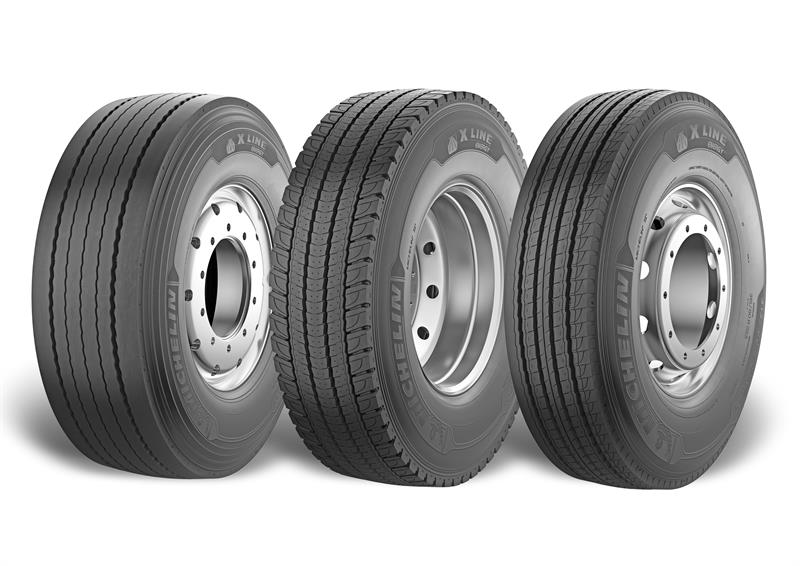An 11% fuel saving just by changing tyres: is this possible? Research by Volvo Trucks indicates that it is, but only when switching from the least suitable tyre types to tyres with low rolling resistance normally sold for long-haul operations.
But it would seem that there is a catch. Dr Bernd Löwenhaupt, managing director of Sumitomo Rubber Europe, which owns the Falken tyre brand, describes rolling resistance as one of three contradictory tyre performance traits, the other two being grip and wear resistance. In other words, customers keen on fuel efficiency might need to be ready to make a sacrifice. And since wet grip performance is recorded on the tyre label, one might assume that wear has to give. Continental Tyres Group’s technical systems, sales and services manager Ian Jackson states: “There is a trade-off with fuel-efficient tyres; minimum rolling resistance can reduce wear resistance.”
It’s a common conclusion. Speaking about Michelin’s low rolling-resistance tyre range, truck tyre technical manager Rob Blurton says: “Our first-generation of Energy tyres saved fuel over the regional tyres of the time, but operators’ experience was that the mileage potential of the tyre was not as good. That perception has, to a certain extent, stuck,” though he qualifies that by saying that its latest products, called X Line, don’t seem to be much shorter lived than standard regional tyres.
How tyre manufacturers manage to square the circle, and produce a fuel-efficient, long-wearing tyre that meets grip requirements, would appear to be highly technical. Falken, for one, has used supercomputer simulation and particle accelerators to analyse the structural properties of rubber at the nanometre scale.
Löwenhaupt elaborates, stating that most modern tyres are developed following extensive research and testing around rolling resistance, with compounds now utilising silica and alternative oils to achieve reduced rolling resistance while still maintaining effective grip levels.

For example, Falken’s Linam VAN01 tyre for light trucks and vans (pictured, far left) features a compound said to provide not only excellent mileage, superb grip and excellent wear, but also enhanced rolling resistance and so reduced fuel consumption. He claims its rolling resistance is 16% better than its predecessor. (The tyre is rated B/C on its EU tyre label for fuel efficiency.)
A similar strategy is employed at Michelin. Explains Blurton: “Much of the X Line’s advantage comes from replacing a proportion of the carbon black used in the tread compound with silica. This reduces rolling resistance and improves the wearing qualities of the tread.” And the pattern of the tread is the other key distinction.
Tread pattern and compound are the key differences between the Goodyear Dunlop FuelMax low rolling resistance tyre and its KMax regional tyre, according to Laurent Colantonio, commercial tyre technology director. The tread and compound of the FuelMax tyre (pictured, right) will continue to offer fuel benefits as the tyre wears down through use. He adds: “The fuel performance of both a fuel-economy tyre and a standard one will improve in the second half of the tyres’ lives, but the fuel-economy tyre will always retain an advantage.”
This point is picked up by Blurton. “Prolonging tyre life not only saves the cost of replacements, it also reduces fuel consumption: the longer the tyre lasts, the more fuel is saved,” he says. “That’s why we promote regrooving as much as possible: there’s a dual benefit in reducing direct tyre cost and fuel consumption.”
To help improve fuel performance of its EcoPlus tyre, Continental has also altered compounds and tread design. Its Plus Void pattern is said to help reduce deformation and therefore energy loss, while enhancing mileage potential. It has also changed the construction of the tyre (pictured, centre). The EcoPlus is made of a two-layer tread construction, utilising different compounds in the cap and base of the tyre, to reduce the conflict between rolling resistance and mileage performance, according to Ian Jackson. The Conti Hybrid HT3 435/50 R 19.5 and 445/45 R 19.5 have 15% less rolling resistance than previous models, and have earned a ‘B’ rating for fuel efficiency on the EU tyre label.
Unlike Continental, Goodyear Dunlop has kept construction the same across FuelMax and KMax tyres, according to Colantonio. He states: “The carcasses are the same: a KMax can be remoulded as a FuelMax and vice versa.”
HORSES FOR COURSES
Fuel-saving tyres will not benefit all operational duties to the same degree, however. At Continental, Jackson outlines its parameters: “Tyres designed for fuel efficiency are engineered to provide minimum rolling resistance, with their best results achieved when used for motorway and long-distance transport. These increases in efficiency can be significant.” He claims that the Conti EcoPlus offers rolling resistance reductions of up to 26% when compared to its predecessor, which could translate into up to 1.9 litres of fuel per 100km.
 Blurton at Michelin also cautions that its X Line tyres also have their limitations. (X Line Energy range pictured above in trailer, drive and steer models, from left to right.) He states: “Low rolling-resistance tyres like the X Line are good for operations where there are few stops and starts. In these circumstances, they will yield a lower total cost of ownership than regional tyres such as our recently introduced X Multi. To ascertain their suitability for a particular operation, we need to talk to the fleet operator about vehicle type and use. It’s all about the right tyre for the right operation.”
Blurton at Michelin also cautions that its X Line tyres also have their limitations. (X Line Energy range pictured above in trailer, drive and steer models, from left to right.) He states: “Low rolling-resistance tyres like the X Line are good for operations where there are few stops and starts. In these circumstances, they will yield a lower total cost of ownership than regional tyres such as our recently introduced X Multi. To ascertain their suitability for a particular operation, we need to talk to the fleet operator about vehicle type and use. It’s all about the right tyre for the right operation.”
Goodyear Dunlop’s Colantonio seconds that. He adds: “If used on genuine long-haul applications, we see some operators get 300,000km or more out of FuelMax steer-axle tyres. This is partly because long haul, by its nature, will include less harsh braking, acceleration and large steering inputs, and also because many long-haul drivers are highly skilled and kind to their equipment.”
But he cautions that, in mixed duty, regional tyres may also be able to compete in the fuel-efficiency stakes. “The KMax, which is designed for maximum life in regional haulage operations, is also used by long-haul operators seeking to maximise tyre life. We also have fleets using KMax where trucks are doing both long-haul and regional tasks.”
Jackson offers further support. “Many UK fleets manage diverse operations, which include a mix of both urban and longer haul driving, and in such cases fleets can often lower their overall driving costs by choosing a hybrid tyre, for improved fuel efficiency and longer service life. The Conti Hybrid tyre family has been specially developed for combined use on regional roads and motorways, and offers up to 6% better fuel economy and 20% longer service life than previous generation tyres.”
THE ROLE OF MAINTENANCE
Achieving healthy tyre fuel economy also depends on good tyre care. The onus is on the operator to keep up high levels of tyre performance through good tyre maintenance, cautions Michelin’s truck tyre technical manager. He adds: “Alignment and the correct tyre pressures affect rolling resistance, so checks need to be undertaken regularly to ensure ongoing fuel efficiency.”
At Continental, Jackson argues that buyers should keep the big picture in mind. “Fuel-efficient tyres do help reduce fuel costs, but taking a holistic approach to tyre management will give operators the best chance to improve overall environmental impact. Tyres are just one aspect of how operators can improve fuel efficiency. Choosing a tyre best suited to the application and supported by a robust tyre management system across its life, including retread and regroove, is the big-picture approach which can lead to far bigger cost savings for operators.”
FURTHER INFORMATION
IRTE tyre guide – https://is.gd/todaje
IRTE guide to fuel efficiency improvement – https://is.gd/ehekag
EU tyre label testing – https://is.gd/diqudu